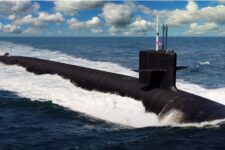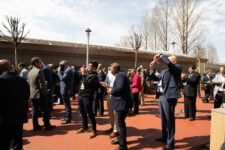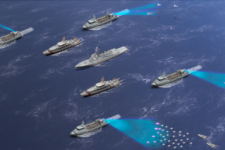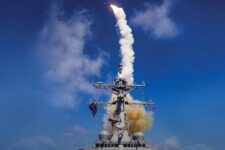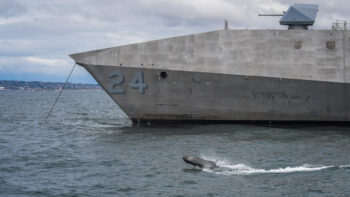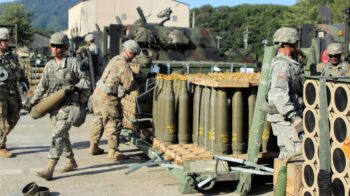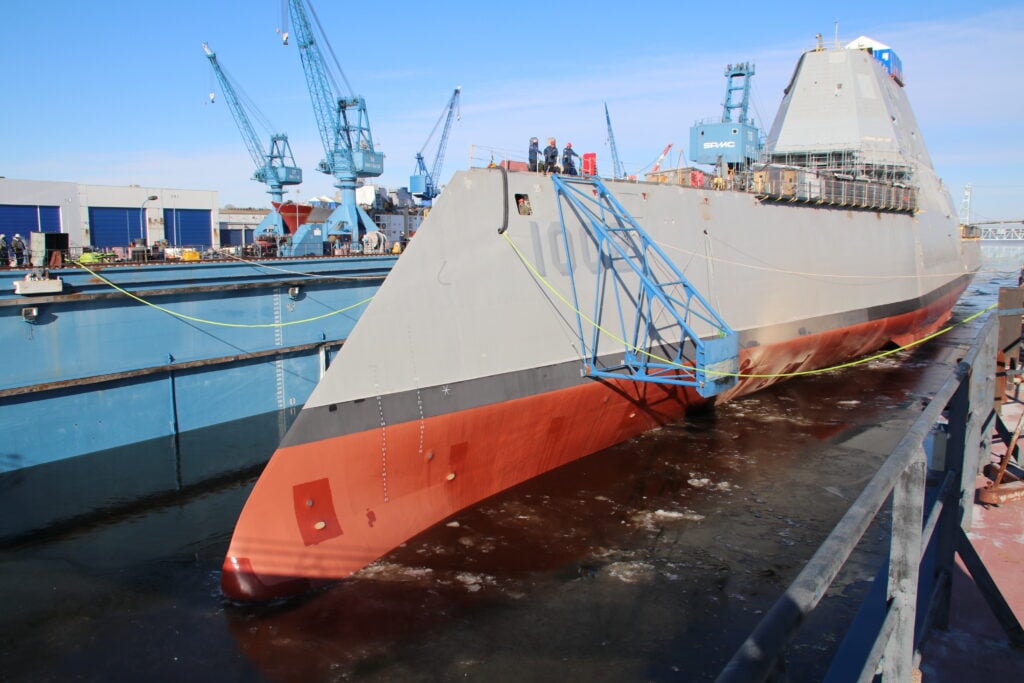
The future USS Lyndon B. Johnson before flooding of the dry dock at General Dynamic-Bath Iron Works shipyard.
WASHINGTON: A round of highly-anticipated talks between Maine’s Bath Iron Works shipyard and the local labor union representing many of the company’s 6,800 employees kicked off this morning, with both sides hoping to keep one of the nation’s most important shipyards humming.
The labor negotiations could have a major impact on delivery of Arleigh Burke destroyers to the Navy, which BIW President Dirk Lesko told me are already running six months behind schedule even as he scrambles to hire several thousand new workers.
“Last year we hired 1,800 people, which was the most hired for 30 years I think,” Lesko said. “The challenge that we have is that, at least prior to COVID-19, the economy was very good, and there’s much less of a manufacturing sector to draw people from here than in other parts of the US. We probably would have hired 500 or 600 more people last year if we could have.”
Some 1,800 new employees are being trained up to replace hundreds of older tradesmen who retired over the past several years after being hired during the last shipbuilding binge in the 1980s. Training the new group has taken time, and slowed some projects down. “Those people are leaving in groups, requiring us to replace them in big groups,” Lesko said.
The talks come after attendance rates at the shipyard dipped by more than half in the early days of the COVID-19 crisis, Workers stayed home due to local closures and the union pushed back over the use of non-union subcontractors. At one point in late March, only 41 percent of workers showed up for their shifts; by the end of April, only about 45 percent of Local S6 union members had clocked in over the previous month.
The delays in work on the destroyers came well before COVID-19 however, and stemmed from a variety of issues: the aging workforce, the time it takes to train skilled workers, and the lingering effects of the delayed work on the Navy’s troubled DDG-1000 Zumwalt destroyers, which is years behind schedule and has eaten up a good portion of the limited pier space at Bath.
Lesko said the workers on the Zumwalt will turn back to their Arleigh Burke work later this year, freeing up labor and space at the pier to begin eating away at those delay times.
But the low attendance rates at the shipyard, demands for pay increases, and company’s use of some non-union subcontractors for some work are major points of contention between the company and the union.
Last week, union leadership posted this on their Facebook page, “it is disheartening that, the very week our membership returns to work as normal after being encouraged to stay out and stay safe due to COVID-19 they are rewarded by subbing out their work. Claiming there were so many people out of work they are now further behind schedule.”
Those issues will begin to be hashed out this week as the two sides look to get production of the Navy’s workhorse destroyers back on track. Lesko told me the schedule slippages occurred before the COVID personnel shortages, but certainly haven’t made up time with so many skilled workers staying home.
The company currently has 11 Arleigh Burkes under contract with six under construction, ships that will be a critical part of the Navy’s long and troubled effort to build a 355-ship fleet by the end of the decade.
“They’re in a tough position going into the labor negotiations because the unions will say ‘you can’t afford a strike so you’ll need to pay,’” naval analyst Bryan Clark of the Hudson Institute said. But any extra costs to the company would incur could make the costs to the Navy also go up. “That could make it harder for Bath to compete” for any future destroyer work, Clark said.
The company had plans to hire another thousand workers this year before the COVID disruption, which stopped the hiring process. “We had a strong pipeline of people in our training programs in place, and our facilities were coming together in a way that I felt pretty confident about,” Lesko said. He added the company plans to get back to that as soon as possible.
While the new workers are being trained and are making their way to the waterfront, the company has dealt with a few stinging defeats.
The loss of the $795 million contract to build the first 10 of a new class of guided missile frigates for the Navy to Wisconsin-based Fincantieri Marinette Marine was a major blow to Bath, as the company looks to life after destroyer work runs out in the coming years. The company also lost out on a hard-fought effort to build the Coast Guard’s Offshore Patrol Cutters in 2016.
Lesko said the company will be in the running for the possibility of a recompete for the frigate contract after the first 10 ships are built, which would put another 10 ships up for grabs. He also expressed hope in talk coming from the Navy that it might be in the market for a new class of large surface combatants in the coming years, but those plans have yet to be fleshed out.
Much of the Navy’s future plans remain in limbo until Defense Secretary Mark Esper finishes his review of the Navy’s force structure plans some time late this summer, which will guide the Navy’s shipbuilding blueprint for the coming decades. Given the outcome of the November presidential election and knock-on effects of the ballooning federal deficit, however, those plans could change again next year as priorities, and budgets, change.
These uncertainties are deeply worrying for the Navy and the Pentagon leadership, as they can ill-afford to lose a shipyard at a time when ship construction and repair are already stressed after years of budget cuts and reduced building rates. The Navy has ambitious plans for a new class of Columbia nuclear-powered submarines, modernizing Virginia-class subs, finishing up the Ford-class aircraft carriers and starting work on the new frigate program. There is also talk of building new classes of smaller amphibious ships and supply vessels to help the Marines in their own transformation efforts. This will take multiple shipyards working on multiple projects at once.
In the near-term, there’s widespread concern over how shipyards are dealing with local manufacturing shutdowns as a result of the COVID-19 crisis.
Navy acquisition chief James Geurts told reporters last week that the Navy has seen around 250 suppliers close due to the pandemic in the past two months, but he’s “seeing many more of those open than close,” in recent days.
His office is tracking 10,000 companies and suppliers, and of those 250, all but 35 are open now, he said. “While we haven’t seen major impacts to current work yet on most of our shipbuilding programs, we are keeping a very close eye on downstream work to make sure that [if] a part we were expecting in September doesn’t show up, we understand how to adjust to that,” he said.
Lesko said that he hasn’t seen much disruption at his shipyard. “There have been modest levels of disruption, a relatively small number of suppliers” that have temporarily shuttered, he said. “We’ve been able to work through all of that with our existing supplier base. I would not want to leave you with the impression that I don’t think the supply base in some cases is fragile, but at least at this point, they have been able to support us and have done quite well.”
Anduril, South Korean shipbuilder HD Hyundai announce new partnership for autonomous systems
US Navy Secretary Carlos Del Toro has praised South Korean shipbuilders such as HD Hyundai at recent events, encouraging more participation with US industry.








